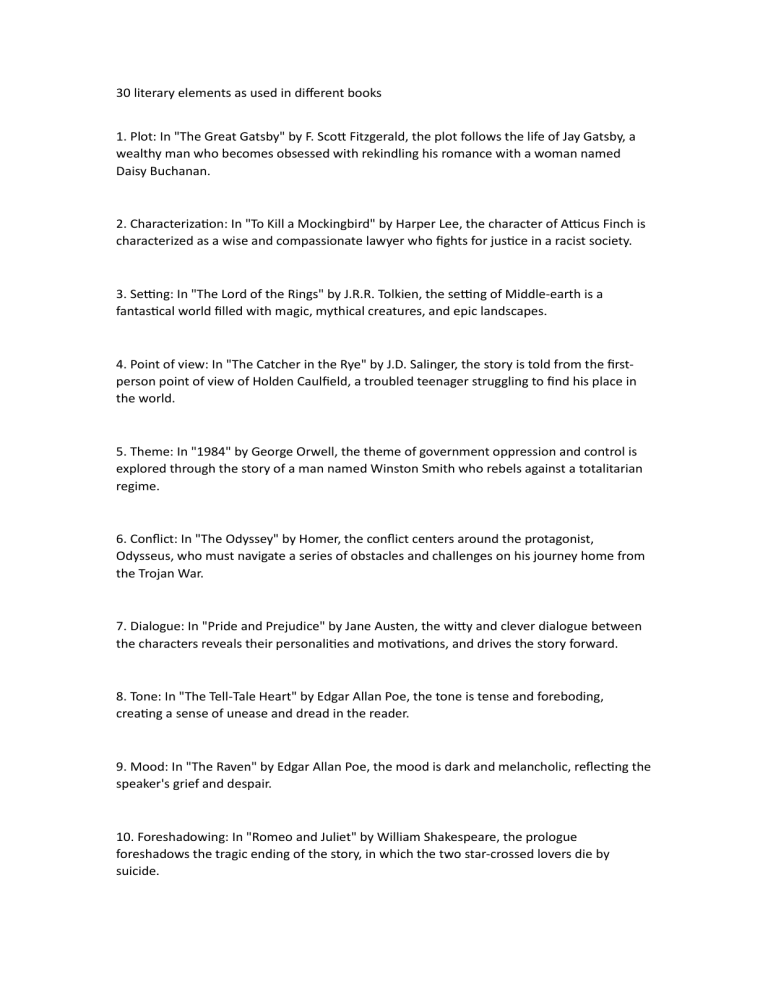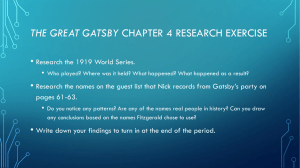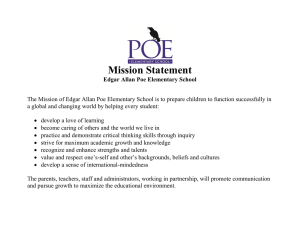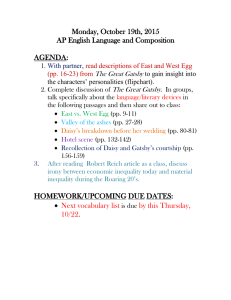
30 literary elements as used in different books 1. Plot: In "The Great Gatsby" by F. Scott Fitzgerald, the plot follows the life of Jay Gatsby, a wealthy man who becomes obsessed with rekindling his romance with a woman named Daisy Buchanan. 2. Characterization: In "To Kill a Mockingbird" by Harper Lee, the character of Atticus Finch is characterized as a wise and compassionate lawyer who fights for justice in a racist society. 3. Setting: In "The Lord of the Rings" by J.R.R. Tolkien, the setting of Middle-earth is a fantastical world filled with magic, mythical creatures, and epic landscapes. 4. Point of view: In "The Catcher in the Rye" by J.D. Salinger, the story is told from the firstperson point of view of Holden Caulfield, a troubled teenager struggling to find his place in the world. 5. Theme: In "1984" by George Orwell, the theme of government oppression and control is explored through the story of a man named Winston Smith who rebels against a totalitarian regime. 6. Conflict: In "The Odyssey" by Homer, the conflict centers around the protagonist, Odysseus, who must navigate a series of obstacles and challenges on his journey home from the Trojan War. 7. Dialogue: In "Pride and Prejudice" by Jane Austen, the witty and clever dialogue between the characters reveals their personalities and motivations, and drives the story forward. 8. Tone: In "The Tell-Tale Heart" by Edgar Allan Poe, the tone is tense and foreboding, creating a sense of unease and dread in the reader. 9. Mood: In "The Raven" by Edgar Allan Poe, the mood is dark and melancholic, reflecting the speaker's grief and despair. 10. Foreshadowing: In "Romeo and Juliet" by William Shakespeare, the prologue foreshadows the tragic ending of the story, in which the two star-crossed lovers die by suicide. 11. Suspense: In "The Hunger Games" by Suzanne Collins, the use of suspense keeps the reader on edge as the protagonist, Katniss Everdeen, fights for survival in a deadly arena. 12. Symbolism: In "The Scarlet Letter" by Nathaniel Hawthorne, the scarlet letter serves as a symbol of shame and sin, representing the guilt of the protagonist, Hester Prynne. 13. Irony: In "Animal Farm" by George Orwell, the irony of the animals' rebellion against their human oppressors is that they eventually become just as tyrannical as their former rulers. 14. Imagery: In "The Road" by Cormac McCarthy, the vivid imagery of the post-apocalyptic landscape adds to the bleak and desolate atmosphere of the story. 15. Allegory: In "The Lion, the Witch, and the Wardrobe" by C.S. Lewis, the story serves as an allegory for Christian theology, with Aslan representing Christ and the White Witch representing evil. 16. Allusion: In "The Waste Land" by T.S. Eliot, the poem is filled with allusions to literary and mythological figures, adding depth and complexity to the work. 17. Hyperbole: In "The Adventures of Tom Sawyer" by Mark Twain, the hyperbole used to describe Tom's adventures adds to the humor and whimsy of the story. 18. Metaphor: In "The Love Song of J. Alfred Prufrock" by T.S. Eliot, the metaphor of a patient etherized upon a table is used to describe the speaker's sense of isolation and detachment. 19. Simile: In "The Odyssey" by Homer, the simile of Odysseus' men being like pigs when they eat the lotus flower emphasizes their loss of self-control and their vulnerability to temptation. 20. Personification: In "The Wind in the Willows" by Kenneth Grahame, the personification of animals adds to the charm and whimsy of the story, as well as to the characters' personalities. 21. Onomatopoeia: In "The Bells" by Edgar Allan Poe, the use of onomatopoeia in the poem's recurring refrain emphasizes the sound and tone of the bells. 22. Repetition: In "The Great Gatsby" by F. Scott Fitzgerald, the repetition of the green light across the bay represents Gatsby's longing for his lost love, Daisy. 23. Rhyme: In "The Raven" by Edgar Allan Poe, the use of rhyme creates a musical and rhythmic quality to the poem, adding to its haunting atmosphere. 24. Meter: In "Beowulf," the use of alliterative meter creates a distinct rhythm and sound that adds to the epic quality of the story. 25. Imagery: In "The Things They Carried" by Tim O'Brien, the vivid imagery of the soldiers'personal items and experiences during the Vietnam War adds to the emotional impact of the story. 26. Flashback: In "The Great Gatsby" by F. Scott Fitzgerald, the use of flashback allows the reader to learn about Gatsby's past and his relationship with Daisy, adding depth to the story. 27. Stream of consciousness: In "Mrs. Dalloway" by Virginia Woolf, the use of stream of consciousness allows the reader to enter the minds of the characters and experience their inner thoughts and emotions. 28. Satire: In "Gulliver's Travels" by Jonathan Swift, the use of satire is used to comment on various aspects of society, including politics, religion, and human nature. 29. Paradox: In "Hamlet" by William Shakespeare, the paradox of Hamlet's madness and his sanity adds to the complexity of his character and the themes of the play. 30. Juxtaposition: In "A Tale of Two Cities" by Charles Dickens, the juxtaposition of the contrasting societies of London and Paris during the French Revolution highlights the themes of social injustice and revolution.




